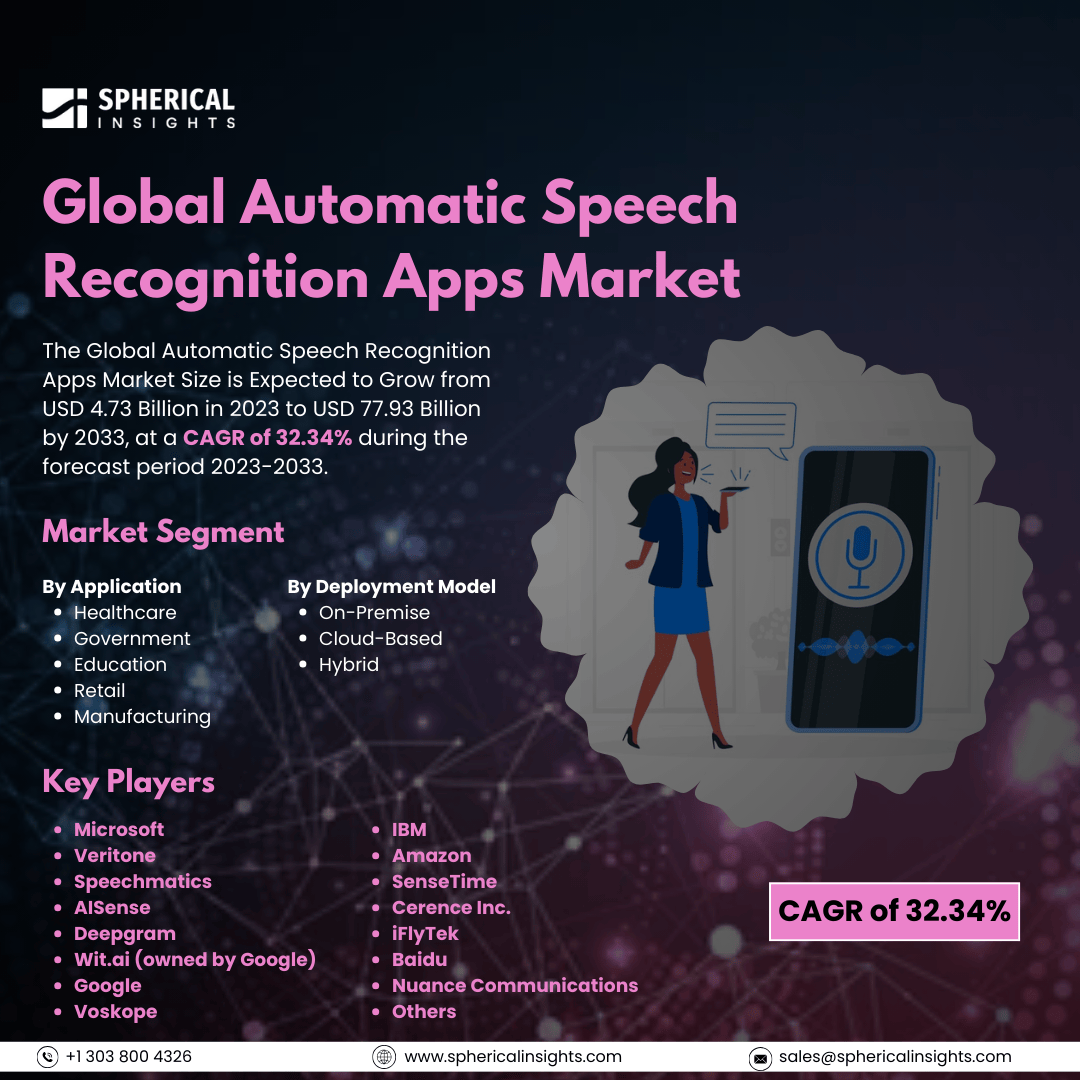Global Automatic Speech Recognition Apps Market Size to worth USD 77.9 Billion by 2033
According to a research report published by Spherical Insights & Consulting, The Global Automatic Speech Recognition Apps Market Size is Expected to Grow from USD 4.73 Billion in 2023 to USD 77.93 Billion by 2033, at a CAGR of 32.34% during the forecast period 2023-2033.
Browse key industry insights spread across 210 pages with 110 Market data tables and figures & charts from the report on the Global Automatic Speech Recognition Apps Market Size, Share, and COVID-19 Impact Analysis, By Application (Healthcare, Government, Education, Retail, and Manufacturing), By Deployment Model (On-Premise, Cloud-Based, and Hybrid), and By Region (North America, Europe, Asia-Pacific, Latin America, Middle East, and Africa), Analysis and Forecast 2023 – 2033.
The curved televisions market represents the global industry that specializes in the design, manufacture, and distribution of televisions with a curved display screen. Such TVs are designed to offer enhanced viewing experiences through the provision of increased depth, contrast, and visual immersion as opposed to flat screens. The curved TV market is mainly driven by advancements in display technologies, such as OLED and QLED, which enhance the visual appeal and functionality of curved screens. Key applications include home entertainment, gaming, and media consumption, where a superior viewing experience is prioritized. The consumer demand for more and more innovative, attractive entertainment technologies and high-end televisions has been the primary driving force of the market. The growing availability of curved televisions with large screen sizes, higher resolution (such as 4K and 8K), and advanced capabilities like smart TV features support market growth. However, the market for curved televisions faces a few challenges. These include high costs, limited availability of content in formats optimized for curved screens, and decreased demand for premium television models in specific regions.
The healthcare segment accounted for the largest share in 2023 and is expected to grow at a significant CAGR during the forecast period.
Based on the application, the automatic speech recognition apps market is classified into healthcare, government, education, retail, and manufacturing. Among these, the healthcare segment accounted for the largest share in 2023 and is expected to grow at a significant CAGR during the forecast period. This dominance is driven by the increasing need for efficient and accurate documentation in healthcare settings, such as medical transcription, electronic health record (EHR) management, and voice-enabled clinical applications. ASR technology helps healthcare professionals transcribe patient records, medical reports, and voice notes quickly and accurately, improving workflow efficiency and reducing administrative burden.
The cloud-based segment accounted for the largest share in 2023 and is expected to grow at a significant CAGR during the forecast period.
Based on the deployment model, the automatic speech recognition apps market is divided into on-premise, cloud-based, and hybrid. Among these, the cloud-based segment accounted for the largest share in 2023 and is expected to grow at a significant CAGR during the forecast period. The cloud-based deployment model is gaining widespread adoption due to its scalability, cost-effectiveness, and ease of integration. Cloud-based ASR apps provide businesses and users with the flexibility to access speech recognition services from any location without the need for heavy infrastructure investments. This model also supports real-time processing and continuous updates, which enhances the performance and accuracy of ASR systems over time.
North America is estimated to hold the largest automatic speech recognition apps market share over the forecast period.
North America is estimated to hold the largest automatic speech recognition apps market share over the forecast period. Several factors contribute to North America's dominant position. The region benefits from a high level of technological adoption and innovation, with advanced infrastructure supporting the widespread integration of ASR technologies across various sectors, including healthcare, retail, education, and government. The presence of key market players, such as major tech companies investing in ASR technology development, further strengthens North America's market leadership.
Asia-Pacific is predicted to have the fastest CAGR growth in the automatic speech recognition apps market over the forecast period. This growth is driven by several factors, including the rapid digitalization of industries, increased adoption of smart devices, and growing interest in voice-based technologies across emerging economies like China, India, and Southeast Asia. The rise of smartphone usage and voice assistants, along with the expansion of e-commerce and retail sectors, is further contributing to the demand for ASR apps.
Company Profiling
Major key players in the automatic speech recognition apps market are, Microsoft, Veritone, Speechmatics, AISense, Deepgram, Wit.ai (owned by Google), Google, Voskope, IBM, Amazon, SenseTime, Cerence Inc., iFlyTek, Baidu, Nuance Communications, and Others.
Key Target Audience
- Market Players
- Investors
- End-users
- Government Authorities
- Consulting And Research Firm
- Venture capitalists
- Value-Added Resellers (VARs)
Market Segment
This study forecasts global, regional, and country revenue from 2023 to 2033. Spherical Insights has segmented the automatic speech recognition apps market based on the below-mentioned segments:
Global Automatic Speech Recognition Apps Market, By Application
- Healthcare
- Government
- Education
- Retail
- Manufacturing
Global Automatic Speech Recognition Apps Market, By Deployment Model
- On-Premise
- Cloud-Based
- Hybrid
Global Automatic Speech Recognition Apps Market, By Regional Analysis
- North America
- Europe
- Germany
- UK
- France
- Italy
- Spain
- Russia
- Rest of Europe
- Asia Pacific
- China
- Japan
- India
- South Korea
- Australia
- Rest of Asia Pacific
- South America
- Brazil
- Argentina
- Rest of South America
- Middle East & Africa
- UAE
- Saudi Arabia
- Qatar
- South Africa
- Rest of the Middle East & Africa



